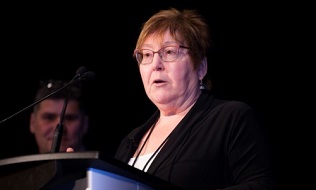

Employers must acknowledge the role of family caregivers to get a true picture of the costs of cancer care, according to a University of Alberta professor.
Janet Fast, a professor of department of human ecology at the University of Alberta, told the audience at Benefits Canada’s 2017 Employers Cancer Care Summit in February that the army of family and friends assisting patients with their everyday needs are an often-overlooked pillar of the medical system. Yet without them, the entire health system would collapse, she noted.
“The caregiver is an integral part of that care team and they too often incur consequences because of the fact that they are providing this care,” said Fast. “It’s not just a benefit to the family member who is receiving the care but also to the labour force and employers and to the economy and society more generally.”
Read: Immuno-oncology shows promise but cost concerns loom
Co-presenter Jean-Eric Tarride used a recent study led by the Caregiver Network on the comparative cost of oral and intravenous chemotherapy to shine a light on the hidden costs of cancer care. On the face of it, he explained that a course of intravenous medicine often appears cheaper than the oral version.
However, because a patient can take oral medication at home, the burden on family caregivers is less because there’s no need for a trip to the hospital.
For example, in the case of a family of Manitoba farmers whose child had Hodgkin’s lymphoma, the parents had to travel to Winnipeg, 300 kilometres from home, 22 times over the course of six months for tests, surgery and chemotherapy. Out-of-pocket expenses related to the trips, in addition to the parents’ lost wages for days off work, added up to about $24,000. They could have avoided some of the costs through the use of oral chemotherapy taken at home, said Tarride, an associate professor at McMaster University.
“The economic benefits of the oral chemotherapy are substantial from a caregiver perspective and more broadly from a societal perspective,” he said.
Read: An employee’s experience with the workplace during cancer treatment
Fast’s research has found that family caregivers provide a mind-boggling 2.4 billion hours of care to patients each year. To put it in context, that’s about 10 times as many hours as those working in formal caregiving roles. According to Fast, about one-tenth of the eight million people who do some level of caregiving each year are looking after someone with cancer, and those numbers will only head up in the coming years.
All of those responsibilities have effects on caregivers’ professional lives, added Fast, who has estimated that caregiving accounts for almost 10 million days of absenteeism each year and more than $1 billion in lost productivity.
As a result, Fast said it’s important to consider their needs when plan sponsors and administrators make decisions about coverage and costs.
Read: Exclusive research results: How do employees with cancer feel about their benefit plans?
“We need to be paying attention to the full set of costs that are incurred. Not just the cost of drug and the cost of treatment, not only the cost to the care recipient whose work may be impacted, but also their supporters whose work may be impacted as well,” said Fast. “There’s a very important role for employers and, by extension, for benefit providers and insurers to play in creating a model that will sustain family carers in a better way than is currently happening.”
